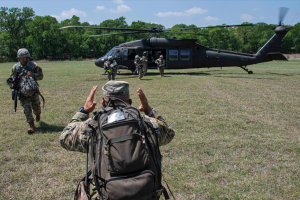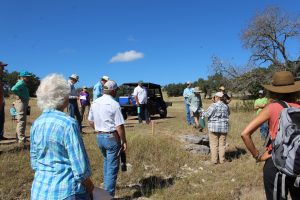GCD Policies Library

Joint Base San Antonio – Camp Bullis provides training opportunities for 266 mission partners; this includes supporting all Department of Defense enlisted and officer medical training. Source: Joint Base San Antonio
In February 2022, land surrounding Joint Base San Antonio—Camp Bullis was nationally recognized as the newest Sentinel Landscape. Located just north of San Antonio, this multi-county area encompasses ranch lands, spring-fed rivers, and the Edwards Aquifer Recharge and Contributing Zones, all within one of the fastest growing regions in the country. With this recognition, the locally driven Camp Bullis Sentinel Landscape Partnership will now have significant new financial resources available to help partners conserve natural resources, strengthen military readiness, and bolster agricultural productivity.
THE SENTINEL LANDSCAPE PARTNERSHIP
The Sentinel Landscapes Partnership is a coalition of agencies and non-governmental organizations that works with private landowners to advance sustainable land management practices around military installations and ranges. Founded in 2013 by the U.S. Department of Defense, Department of Agriculture, and Department of the Interior, the Sentinel Landscape Partnership works with local partners to equip volunteering private landowners with the technical and financial resources necessary to carry out sustainable management practices on their properties. A Federal Coordinating Committee comprised of the three Departments formally recognizes and supports local Sentinel Landscapes. This official recognition provides several years of support for a local partnership coordinator, priority consideration for funding from DOD, USDA, and DOI, as well as rare flexibility to match certain federal dollars with federal dollars. There are ten Sentinel Landscapes across the country; each promotes sustainable management practices in farming, ranching, and forestry that offer economic and ecological benefits while also protecting defense facilities from development that can constrain the military’s ability to carry out important training and testing activities.
GROUNDWATER STEWARDSHIP
Over the years, growth in San Antonio has been creeping toward Camp Bullis, and the associated light pollution was having a detrimental effect on the base’s night training mission. In an effort to protect Camp Bullis and the surrounding natural environment, the Hill Country Alliance, Texas A&M Natural Resources Institute, and the Alamo Area Council of Governments came together in 2020 to create a partnership and explore opportunities to expand conservation funding for the area. Dozens of other entities joined the effort, including conservation organizations, chambers of commerce, academic institutions, and military agencies. TAGD members involved in this locally led, collaborative consortium are Trinity Glen Rose GCD, Cow Creek GCD, and the Edwards Aquifer Authority.
“The Trinity Glen Rose GCD saw an opportunity to increase partnerships with other organizations in the region that benefit each other and benefit the districts mission and goals to promote groundwater protection, preservation, and conservation of the Trinity Aquifer. The goals of the Sentinel Landscape designation align in the protection of Camp Bullis and its military readiness by addressing groundwater availability and quality of the site. The promotion of land stewardship and preserving the working and rural landscapes and keeping them intact, strengthens existing and future farms and ranches which conserves and protects the groundwater resources of the Trinity Aquifer that Camp Bullis overlies and produces groundwater from.” said Amanda Maloukis, Assistant General Manager of Trinity Glen Rose GCD.

Hill Country landowners gather to discuss stewardship practices for enhancing soil moisture and grass production, reducing erosion, and mitigating flooding. Source: HCA
The Camp Bullis Sentinel Landscape is defined by its unique surface and groundwater resources. In addition to the San Antonio and Guadalupe rivers that cross through the Sentinel Landscape, the area also contains portions of the Edwards Aquifer Recharge and Contributing Zones. The Camp Bullis Sentinel Landscape partners hope to improve watershed health and promote landscape resilience through water quality and quantity initiatives to protect the Edwards Aquifer and Trinity Aquifer, which are both key water resources for Camp Bullis and the rapidly growing area around it. Daniel Oppenheimer, the Land Program Director for the Hill Country Alliance and lead coordinator for the partnership, explains the groundwater focus for the project – “With Joint Base San Antonio-Camp Bullis drawing its drinking water from the Trinity Aquifer, that expands the narrative. Groundwater conservation is not only important for local, Texas communities and endemic species. It’s also tied to military readiness and national defense.”
The Camp Bullis Sentinel Landscape project focuses on supporting willing private landowners with technical and financial resources that align with the landowner’s stewardship goals, such as improving soil health and infiltration, managing hillside erosion and creek-bank stability, and increasing native plant diversity and abundance. Healthy soils and functioning riparian areas, in turn, mitigate flooding, support groundwater replenishment, and filter pollutants.
WHAT NEXT?
Since the official designation earlier this year, the Camp Bullis Sentinel Landscape’s partners have been hard at work seeking public and private funding. Landowners within the multi-county focal area will then have the opportunity to apply for funds to implement improved land management and building practices. Just last month, partners submitted an $8.5 million proposal to the USDA Regional Conservation Partnership Program to support landowners’ efforts to improve soil health and ground water replenishment. With a dynamic project area that encompasses urban, suburban, exurban, and rural areas, partners aspire to support a variety of stewardship practices that enhance groundwater replenishment in these different settings.
Camp Bullis continues to serve as an important training ground for all four branches of the armed services, including all military medics. The conservation initiatives in this project will help protect not only the land and water surrounding Camp Bullis, but also safeguard the best training environments for our country’s service members.
To learn more about the Camp Bullis Sentinel Landscape partnership, visit the project site at the Hill Country Alliance website or contact any of the GCD partners.
Thanks to Daniel Oppenheimer (Hill Country Alliance) and Amanda Maloukis (Trinity Glen Rose GCD) for their contributions to this article.
